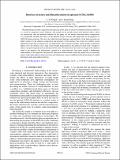| dc.contributor.author | Kolpak, Alexie M. | |
| dc.contributor.author | Ismail-Beigi, Sohrab | |
| dc.date.accessioned | 2012-07-20T18:21:21Z | |
| dc.date.available | 2012-07-20T18:21:21Z | |
| dc.date.issued | 2012-05 | |
| dc.date.submitted | 2012-01 | |
| dc.identifier.issn | 1098-0121 | |
| dc.identifier.issn | 1550-235X | |
| dc.identifier.uri | http://hdl.handle.net/1721.1/71736 | |
| dc.description.abstract | Phenomenological models suggest that thin epitaxial SrTiO[subscript 3] films on silicon will exhibit ferroelectric behavior as a result of compressive strain. However, such models do not include atomic-scale interface effects, which can dramatically alter the predicted behavior. In this paper, we use density functional theory computations to systematically elucidate the effects of the interface atomic structure and composition on the properties of SrTiO[subscript 3]/Si heterostructures. We show that while the band alignment and metallicity of the heterostructure are highly sensitive to the chemical composition and geometry of the interface, the system also exhibits several important features that are universal to all compositions. These universal features, which include an electronic dipole across the interface and a large cation-oxygen displacement in the interfacial oxide layer, conspire to induce a net positive polarization in ultrathin SrTiO[subscript 3] films. We demonstrate that, due to its origin in the chemical bonds at the interface, this polarization is pinned in a single direction. Our results provide a fundamental understanding of the important role played by interfacial chemical bonds within the general class of atomically abrupt, oxide-semiconductor heterostructures and, furthermore, suggest guidelines for the future design of coupled functional oxide-semiconductor devices. | en_US |
| dc.description.sponsorship | National Science Foundation (U.S.) (Grant No. CNS 08-21132) | en_US |
| dc.description.sponsorship | National Science Foundation (U.S.). Materials Research Science and Engineering Centers (Program) (DMR) 1119826 (CRISP) | en_US |
| dc.description.sponsorship | National Science Foundation (U.S.). Materials Research Science and Engineering Centers (Program) (DMR) 0520495 (CRISP) | en_US |
| dc.language.iso | en_US | |
| dc.publisher | American Physical Society | en_US |
| dc.relation.isversionof | http://dx.doi.org/10.1103/PhysRevB.85.195318 | en_US |
| dc.rights | Article is made available in accordance with the publisher's policy and may be subject to US copyright law. Please refer to the publisher's site for terms of use. | en_US |
| dc.source | APS | en_US |
| dc.title | Interface structure and film polarization in epitaxial SrTiO[subscript 3]/Si(001) | en_US |
| dc.type | Article | en_US |
| dc.identifier.citation | Kolpak, A., and S. Ismail-Beigi. “Interface Structure and Film Polarization in Epitaxial SrTiO_{3}/Si(001).” Physical Review B 85.19 (2012). ©2012 American Physical Society | en_US |
| dc.contributor.department | Massachusetts Institute of Technology. Department of Mechanical Engineering | en_US |
| dc.contributor.approver | Kolpak, Alexie M. | |
| dc.contributor.mitauthor | Kolpak, Alexie M. | |
| dc.relation.journal | Physical Review B | en_US |
| dc.eprint.version | Final published version | en_US |
| dc.type.uri | http://purl.org/eprint/type/JournalArticle | en_US |
| eprint.status | http://purl.org/eprint/status/PeerReviewed | en_US |
| dspace.orderedauthors | Kolpak, A.; Ismail-Beigi, S. | en |
| dc.identifier.orcid | https://orcid.org/0000-0002-4347-0139 | |
| mit.license | PUBLISHER_POLICY | en_US |
| mit.metadata.status | Complete | |
